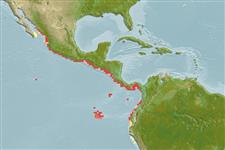>
Eupercaria/misc (Various families in series Eupercaria) >
Lutjanidae (Snappers) > Lutjaninae
Etymology: Lutjanus: Malay, ikan lutjan, name of a fish.
Eponymy: Dr David Starr Jordan (1851–1931) was a leading American ichthyologist, physician, educator, peace activist and believer in eugenics; moreover, he was founding President of Stanford University. [...] (Ref. 128868), visit book page.
More on author: Gilbert.
Environment: milieu / climate zone / depth range / distribution range
Ecología
marino asociado a arrecife; rango de profundidad 0 - 50 m (Ref. 55), usually 40 - 50 m (Ref. 9313). Tropical; 26°N - 10°S, 110°W - 77°W (Ref. 55)
Eastern Pacific: southern Mexico to Peru, including the Mapelo, Cocos and Galapagos islands.
Tamaño / Peso / Age
Maturity: Lm ? range ? - ? cm
Max length : 60.0 cm TL macho / no sexado; (Ref. 9313)
Short description
Claves de identificación | Morfología | Morfometría
Espinas dorsales (total) : 10; Radios blandos dorsales (total) : 14; Espinas anales: 3; Radios blandos anales: 9. Head pointed, dorsal profile of forehead somewhat angular. Preorbital bone broad, maxilla extending nearly to mid-eye level. Preopercular notch and knob well developed. Scale rows on back parallel to lateral line. Upper back and top of head dark olive; sides and ventral parts dark purplish; silvery spots on side forming longitudinal rows.
Adults are found over hard bottoms in inshore reef areas. They form schools in surface waters around Cocos Island, Costa Rica (Ref. 9313). Carnivorous, feed on invertebrates and fish (Ref. 9313).
Life cycle and mating behavior
Madurez | Reproducción | Puesta | Huevos | Fecundidad | Larva
Allen, G.R., 1985. FAO Species Catalogue. Vol. 6. Snappers of the world. An annotated and illustrated catalogue of lutjanid species known to date. FAO Fish. Synop. 125(6):208 p. Rome: FAO. (Ref. 55)
IUCN Red List Status (Ref. 130435: Version 2024-1)
Threat to humans
Harmless
Human uses
Pesquerías: comercial; pesca deportiva: si
Herramientas
Special reports
Download XML
Fuentes de Internet
Estimates based on models
Preferred temperature (Ref.
123201): 17.6 - 25.4, mean 20.8 °C (based on 5 cells).
Phylogenetic diversity index (Ref.
82804): PD
50 = 0.5000 [Uniqueness, from 0.5 = low to 2.0 = high].
Bayesian length-weight: a=0.01479 (0.00706 - 0.03101), b=2.97 (2.80 - 3.14), in cm total length, based on LWR estimates for this Genus-body shape (Ref.
93245).
Nivel trófico (Ref.
69278): 4.5 ±0.8 se; based on diet studies.
Resiliencia (Ref.
120179): Medio, población duplicada en un tiempo mínimo de 1.4-4.4 años (Preliminary K or Fecundity.).
Fishing Vulnerability (Ref.
59153): Moderate vulnerability (44 of 100).
Climate Vulnerability (Ref.
125649): Very high vulnerability (86 of 100).
Nutrients (Ref.
124155): Calcium = 29.3 [17.9, 44.4] mg/100g; Iron = 0.338 [0.215, 0.553] mg/100g; Protein = 18.6 [17.1, 19.9] %; Omega3 = 0.13 [0.09, 0.19] g/100g; Selenium = 56.4 [33.7, 91.5] μg/100g; VitaminA = 222 [43, 884] μg/100g; Zinc = 0.352 [0.267, 0.501] mg/100g (wet weight);
